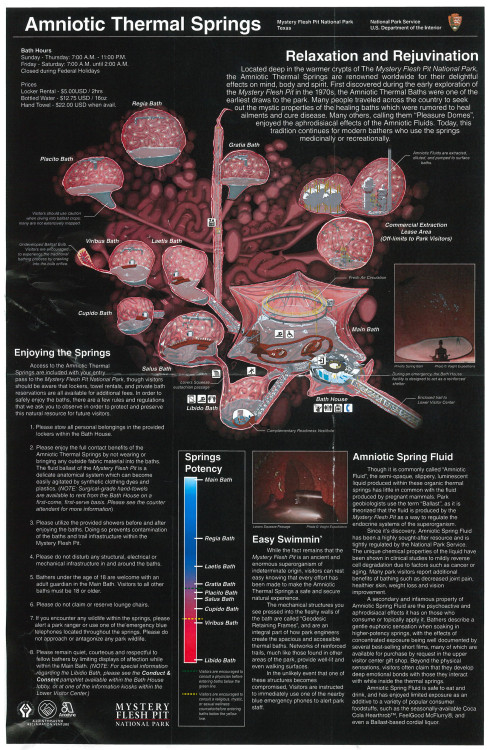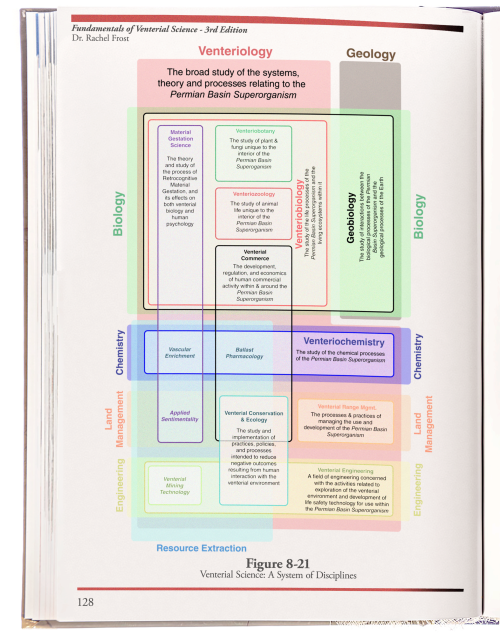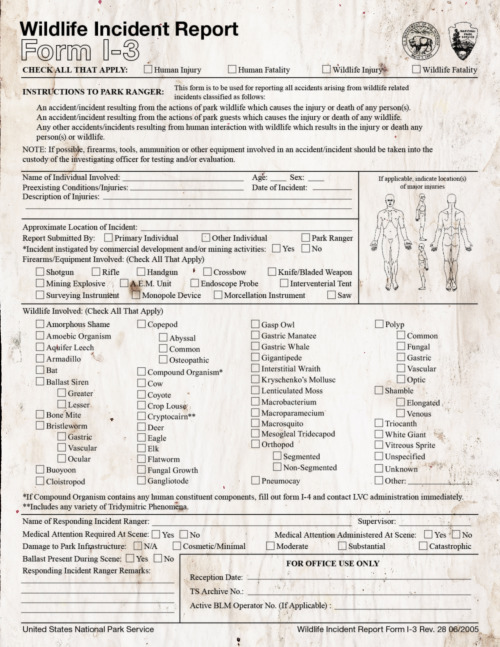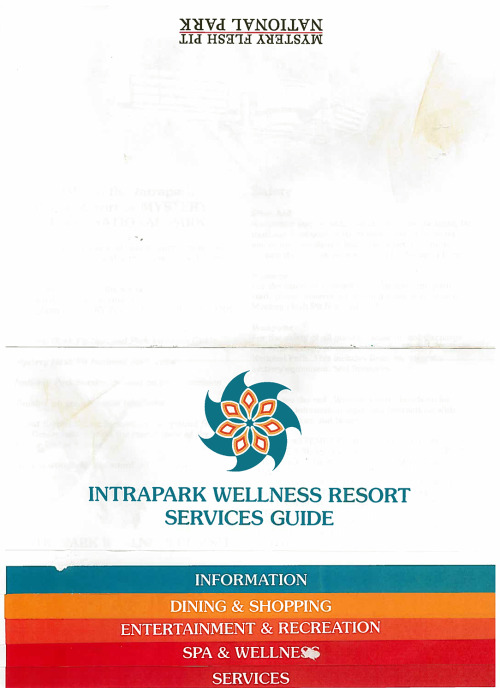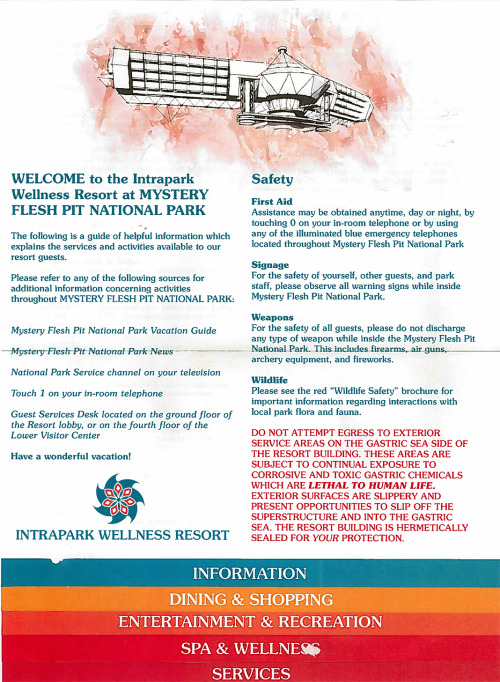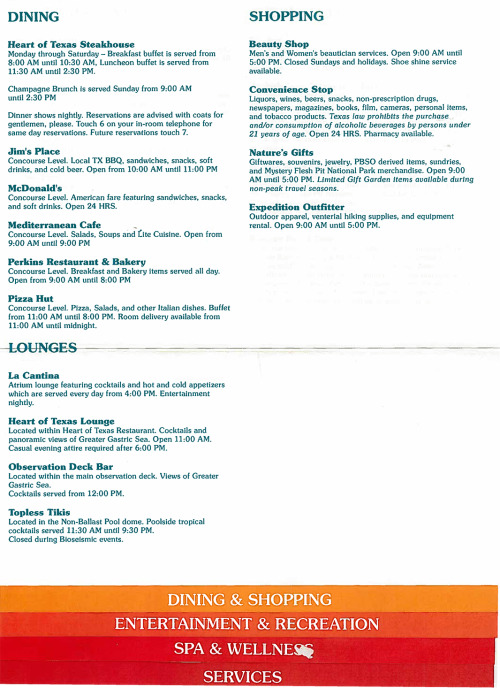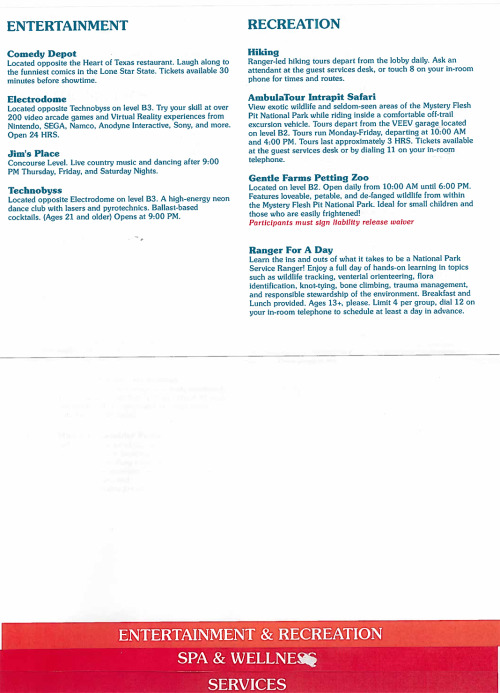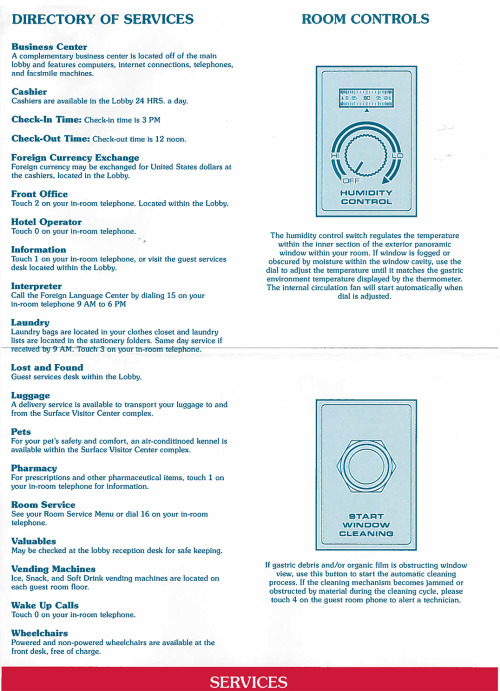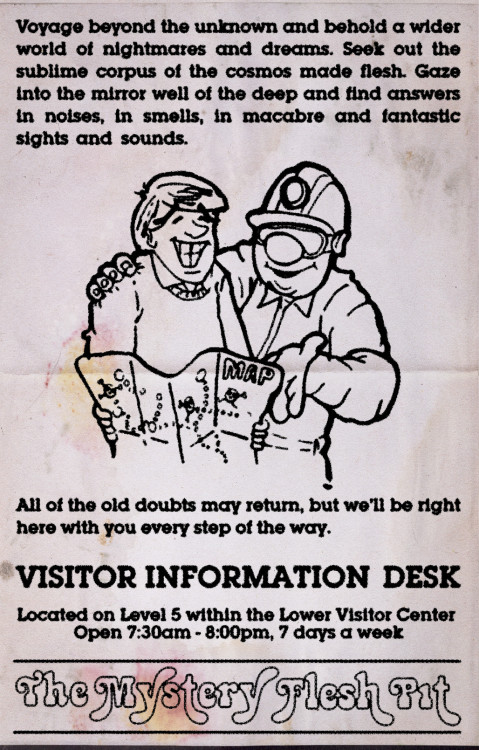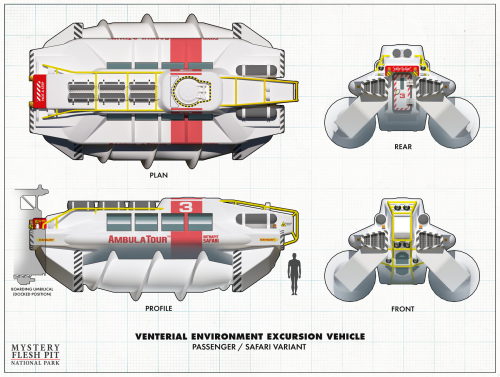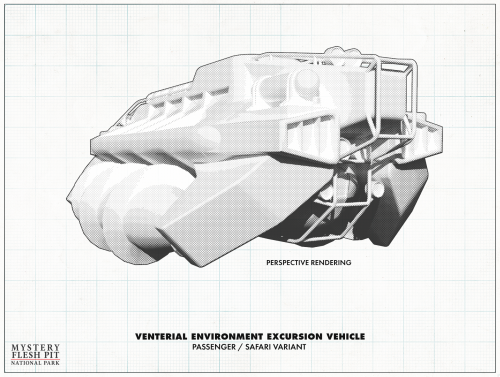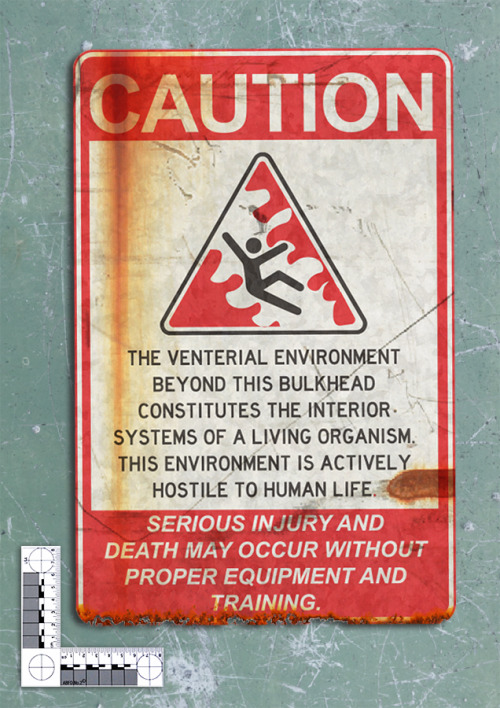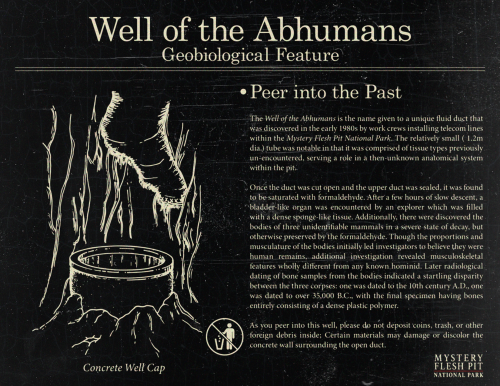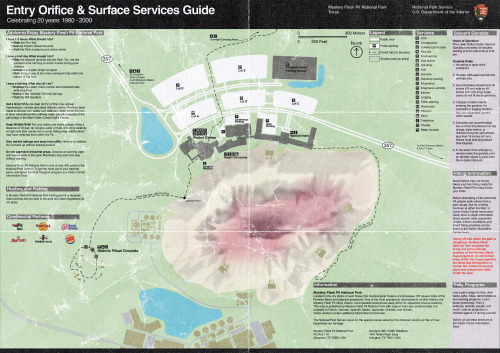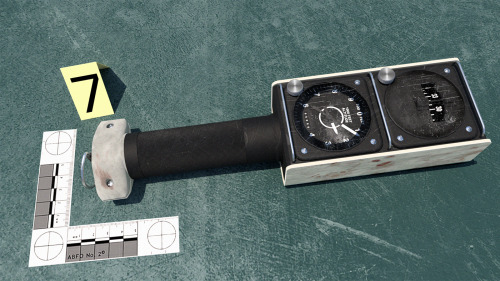#mystery flesh pit national park
@ainsley4ever asked:
Is the main entry orifice the only one the Mystery Flesh Pit possesses? If not, were the other ones also used by Anodyne for resource exploitation?
While the main Entry Orifice depicted in all of the Marketing and Outreach media for the Mystery Flesh Pit, an additional 14 orifices were eventually discovered, bringing the total number to 15. These 14 additional orifices, along with the main Entry Orifice, are loosely arranged in a circle around the true center of the Permian Basin Superorganism, which contains no orifice of any kind. Unlike the extensively dilated and excavated main orifice, these 14 additional orifices are much smaller and harder to locate. Each of these smaller orifices has been appropriately “capped” to prevent ingress by the Bureau of Land Management, though at least two orifices were utilized by the Anodyne corporation for limited logistics and resource extraction purposes. In the early 2000s, ambitious plans were drawn up to eventually develop one or more of these additional orifices into a “Second Gate” for tourism, but the 2007 tragedy curtailed any such plans. Today, these formerly Anodyne-maintained orifice facilities are operated by the Permian Basin Superorganism Containment corporation in service of their containment and research operations.
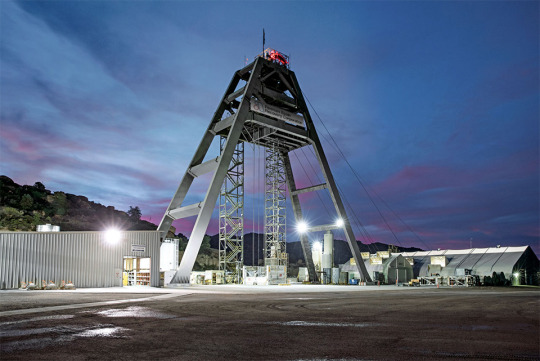
@bloatypizzahog asked:
Did the Roadless Rally go into the pit itself?
The Roadless Rally off-road racing series took place entirely within the pit, specifically within the large cavity created by damming of the Lesser Gastric Sea with the construction of the Fred J. Agnich Gastric Dam. This large cavity was initially created to house a temporary worker village during the early development of the park facilities. Once these temporary housing & fabrication facilities were no longer needed, the area was leased to a rally racing league for an experimental new form of off-road rally racing. Despite the enormous costs sunk into the creation and advertisement of the new racing program, viewership was limited enough that the experiment was considered a failure and was not pursued beyond the 1989 season.
@crashlandingcity asked:
The existence of large mining rigs and commercial constructions like the Intrapit Thermal Wellness Resort far from the main National Park entry orifice hint at a commercial operation on a scale that almost overshadows the park complex. What kind of support and logistics infrastructure existed (exists?) for these large-scale heavy industries and construction projects?
Despite the two other entry orifices mentioned in an answer above, almost all of Anodyne’s equipment and infrastructure depended heavily on use of the main Entry Orifice. Large equipment such as the mining rigs were constructed in situ by lowering large pieces of the vehicles down the main articulated elevator gantry. As the scale of these vehicles suggest, it is correct to assume that the commercial extraction operations were of a far larger scale than that of the National Park. Today, the full extent of these extraction activities is unknown with many records presumed lost during the liquidation of the company’s assets following it’s 2008 bankruptcy.
Anonymous asked:
Why was aconitine the chosen paralyzing agent for the superorganism instead of a more standard anesthetic?
Anodyne Chemicals was already a contracted supplier of specialty-use poisons for the Department of the Interior, and had prior capability to produce Aconitine at-scale. In short, it was the least economically-disadvantageous of the chemical candidates which were considered.
@mikuworshiper asked:
I’m sorry if I just missed it on the anatomy charts, but does the superorganism have a brain? do you think it is conscious
The Permian Basin Superorganism contains what Geobiologists term a “Distributed Heuristic Hierarchical Nervous System”. The chart below offers a cursory illustration of how this sort of Neural arrangement functions: Surrounding the center of the Superorganism is a vast ring of neural tissue resembling an organic fiber-optic bundle. This central ring connects five enormous, miles-wide concentrated brain regions which are theorized to comprise a central nervous system used by the Superorganism to simultaneously “think” as well as manage the many hundreds of miles of the Mystery Flesh Pit’s anatomy. This management system is further divided into hundreds of “Superganglia” managed by each pentalobe, broadly categorized into “Alpha”, “Beta”, and “Gamma” variants. “Alpha” ganglia manage thousands of local nerve clusters responsible for executive functions such as motor control, digestive management, lymph production, vascular management, as well as dozens of other functions. “Gamma” ganglia are almost the reverse counterpart to the “Alpha” ganglia. “Gamma” ganglia manage the many thousands of nerve and sensory receptors throughout the Mystery Flesh Pit, translating this enormous amount of information into useable data for the central Pentalobal Nervous System. Unique are the many “Beta” ganglia clusters which seem to fill in a sort of “local memory” function which has no direct analog in mainstream biology. These “Beta” ganglia clusters exhibit phenomenal storage capability for stimuli-response memory, and were often harvested for their biotechnological applications before the 2007 tragedy.
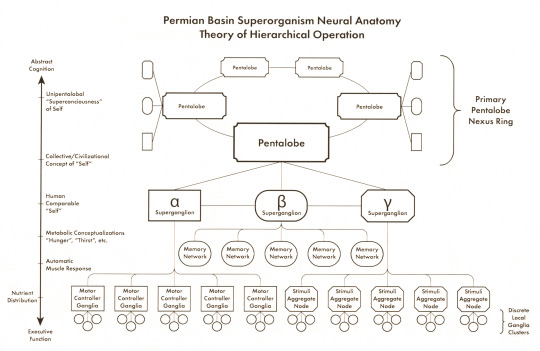
Anonymous asked:
Do we have any idea what the full body of the Permian Basin Superorganism looks like, or have scientists only observed the part of it that lies directly beneath Mystery Flesh Pit National Park?
Broadly speaking, yes, Geobiologists and Venteriobiologists have reached a general understanding that the Permian Basin Superorganism exhibits a basic pentadecagonal symmetry, though this should not be taken to mean that the Mystery Flesh Pit is simply a “Fifteen-legged starfish”. While it is symmetrical in plan, it’s vertical composition is far less well understood and still remains a matter of staunch controversy.
Anonymous asked:
The 2007 disaster report stated that several wounded visitors walked back into the maw of the pit. Was there any follow up as to why they might have done this?
Each individual’s reason for returning to the pit will always be known only to them, but it has been widely understood in the decade plus since that many of these individuals attempted return to the orifice out of a sense of obligation to help loved ones who still remained within the park. Since it’s publication, the official 2007 report has been criticized for it’s over-reliance on technical explanation in contrast to more subjective, common-sense “folk wisdom” regarding certain elements such as the “inexplicable” return of these individuals to the entry orifice following the disaster.
@mintposting asked:
Did the term ‘venteriology’ originate from studies around the pit, or did it exist beforehand?
It evolved entirely in the shadow of the Mystery Flesh Pit’s discovery, loosely meaning “The Study of that which is Under/Below”.
Anonymous asked:
is james jackson still alive? whats he doing nowadays?
James Jackson tragically died during the winter of 2006 at age 58 due to a collision with a drunk driver. Though he never married, and is survived by no living relatives, the Philanthropic and Activist-driven non-profit he began, the Jackson Foundation, still continues it’s mission to this day.
@badsy-edgecat asked:
has anything resembling optic nerves or related organs been discovered in the pit?
Yes. The Project Touchstone expedition, which aimed to plot a horizontal navigable course from the main Entry Orifice to an extremity of the Superorganism, discovered an organ at the furthest extremity of their route that was determined to be analogous to an optical sensory organ or eye. This “eye”, determined to be one of many thousands along a band of the Superorganism’s upper mantle, was measured to be approx. 1.2km in diameter, with multiple optic nerve connections, a retinal region many times larger than a regulation football field, and a highly evolved lens configuration comprising over two dozen discrete lens and filter elements. This large “eye” organ, as well as the other thousands of identical organs, appeared to be generally retracted into an inner carapace lining which separated these organs from the direct rock face of the surrounding geological strata.
dykepixie asked:
What is the longest amount of time someone has ever spent in the Pit and been successfully recovered alive, not counting the, uh, formerly amalgamated people? We know that miners spent (spend?) months at a time in the Pit, but outside of that? Has anyone ever been lost and presumed deceased, but then shown up again later?
The longest known instance that I was able to find of an individual surviving in the pit involved one of the original 38 individuals who returned to the entry orifice immediately following the 2007 disaster. The individual (whose name has not been made public) was a 41-year old male originally assigned within trauma group “A”. While this information has not been verified by either the NPS, the DoI, or the PBRCC, I have strong reason to believe that this “missing” individual was recovered in 2019 by PBRCC teams within the pit. The individual, originally presumed dead, was discovered by a surveying team. The man was naked and had sustained a tremendous amount of physical and genetic abuse, widly screaming at the sight of the surveyor’s worklights. The individual, in a frenzied and panicked state, latched onto the metal frame of a work vehicle with such force that his arms and legs became severely bruised with risk of internal bleeding. After being brought to the surface, still maintaining a death-grip on the vehicle, the man was placed under intensive medical care to repair the injures and deformities he sustained during his 12 years within the pit. I know that he was given a robust regimen of physical and emotional therapy, but I do not know if he was/is rehabilitated to the degree where he would be willing to answer any of my emails regarding his time in the raw pit fleshscape. Only time will tell.
Anonymous asked:
Was the Interpit resort owned by a chain? Was it more rustic (like, national park “outdoorsy”), or more luxury?
It was designed to offer the pinnacle of (1985) contemporary luxury.

@nnaassttyy asked:
What are some of the largest recorded (or rumored) amalgamations?
Venteriologists theorize that, hundreds of years ago, a stampede of over a thousand long-horn cattle were surreptitiously “swallowed” by one of the Superorganism’s orifices during either a migration or cattle-drive. These thousands of cattle underwent simultanous mass amalgamation, but were able to survive to the sheer scale of the resulting organism, being able to consume itself. Over time, this highly-immobile mass of horned, writhing bovinity was enveloped in a cocoon of tissue grown by the Superorganism believed to be related to some digestive purpose. Because of the now-concentrated collection of horns, however, a persistant hole in this tissue sac survives to this day. This tear in the tissue lining, combined with the still rhythmic suffering of this animal collective, was known to park visitors as the “Peeking Druid” geobiological formation.
Anonymous asked:
there’s a typo in you FAQ. Under “Will there be a book?” you wrote “an book” instead of “a book”.

Anonymous asked:
Have any baseball (or sport teams) ever celebrated their victory or even played in a special location at the Flesh Pit?
To my knowledge, no professionally-organized sporting events (besides the aforementioned off-road rally) took place within the Mystery Flesh Pit National Park. However, victory celebrations of all types were common. The resorts and facilities found within the park were of a world-class caliber and while a difficult sell at first blush, were famously exalted by guests who had actually stayed within the Interpit resort.
@fruitsofaphrodite asked:
Has anything been noted of in regards to the children conceived in the pleasure domes??
It is a common misconception that, due to the nature of the Amniotic Thermal Springs and their effects, there must have been a surplus of children conceived within the Mystery Flesh Pit. On the contrary, the spermicidal effects of Ballast were a notorious (if under-marketed) reason for the Thermal Springs lucrative operation.
Anonymous asked:
The interior services guide mentions people being allowed to hunt and fish within the pit if granted a license. We are aware of some of the main types of “terrestrial” fauna within the pit, but what sorts of creatures could be fished?
You know, normal stuff.
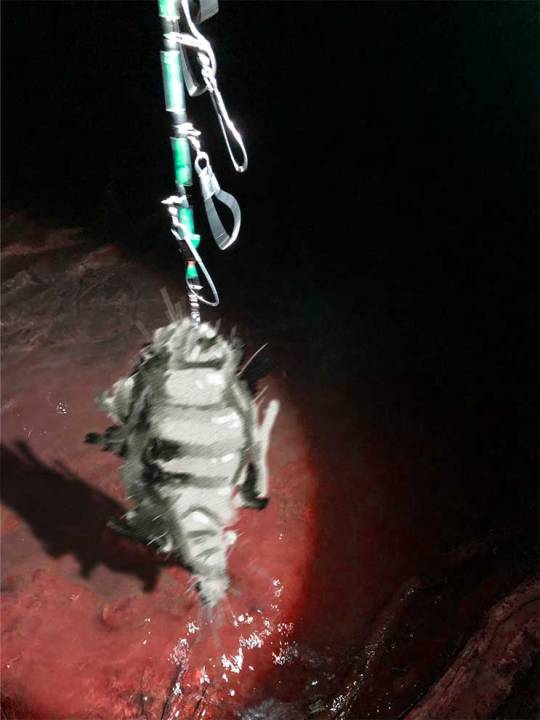
This scan of a 2006 pamphlet offers information about the Amniotic Thermal Springs, known by many as “Pleasure Domes”, within the now-closed Mystery Flesh Pit National Park. The thermal baths were one of the highlights of the park, drawing in tens of thousands of visitors each year, particularly during the cold winter months. It was only after the park permanently closed in 2007 that the long-term effects of exposure to the “Amniotic Spring Fluid”, or ballast, became apparent. Many of those who routinely soaked in the baths underwent depressive withdrawal periods, as the price of extracted ballast fluid since the tragedy has skyrocketed. Today, only those willing to spend thousands of dollars on purchasing the illicit substance can experience this enchanting elixir.
Post link
Want to grab one of these? Head over to https://mfpgiftshop.storenvy.com/. They are very limited; only 70 of these iron-on, exclusive embroidered Mystery Flesh Pit National Park patches are in stock, and once they are sold out, they will be gone forever. Sold Out!
P.S.Patreon subscribers at the “Park Benefactor” tier each received one of these for free as a surprise giveaway. If being included in that kind of super-secret content is appealing to you, consider becoming a patron!
Post link
Like many aspects of the Mystery Flesh Pit, the more visceral reality of the pit was usually glossed in a more clinical veneer by the professionals who studied and worked within it. This treatment extended to the often cryptic vocabulary used to refer to different elements and fields of activity surrounding the pit. Shown here is a chart which illustrates the differences and similarities between these interconnected scientific, political, and commercial fields.
Post link
An overview presentation of the 1979 Survey Expedition into the Mystery Flesh Pit.
As any Park Ranger could tell you, no volume of safeguards or training will prevent a park guest from interfering with wildlife. The notoriously dangerous environment of the Mystery Flesh Pit National Park necessitated a highly specialized corps of rangers to respond to incidents involving wildlife and guest safety, but this was often not enough to prevent tragedy. With the 2007 closure of the Mystery Flesh Pit removing much of the context surrounding the activities within the former park, it is easy to look at these sorts of ephemeral traces of hazard management with a sense of detached wisdom that mischaracterizes the fundamental draw of the park in the first place: the danger was a heavily-marketed, inherent thrill and a major attractor of visitors. It was the management of those hazards which presented the real and insidious problem of the pit.
Post link
Scans of an in-room service brochure from the Resort-Hotel constructed within the Mystery Flesh Pit National Park, most likely from around 1998-2000.
The Interpark Wellness Resort was one of the most ambitious achievements of the NPS/Anodyne partnership and saw healthy attendance and continual growth throughout it’s ill-fated service life. This service brochure gives a glimpse into the scale of development that was occurring within the National Park, and should indicate the degree to which Anodyne and its partners were making fortunes from the exploitation of the Permian Basin Superorganism.
These sorts of items are hard to find in this condition, as the Interpark Resort suffered tremendous damage after the 2007 disaster. Structurally, the facility was built into the wall of the Greater Gastric Sea in the location of an existing ulcer and was anchored by hundreds of hydraulic rams and suspension cables. After years of neglect and abandonment, many speculate that the resort is at great risk of collapsing into the churning acid sea surrounding it.
Post link
Dear Brandon,
I’m writing you back about your Career Report Project for school. I hope you find my response satisfactory; it’s my experience, and it’s all true.
I was 17 when I signed on with the company to work a full tour. The money they promised for 9 months of work was more than I could have made in a lifetime in any other career; I was a shitkicking dropout from Hobbs.
Most people already know that the real money is made in pumping up Ballast, but they have it automated to the point where you only need someone to babysit the equipment. What a lot of people don’t know is that there are a bundle of other minerals, gels, gases and oozes that are worth more than their weight in gold for their “Myriad Industrial Applications”. The big three are “Blue” (Blue Tissue), “Pearls” (Corpusite), and “Black Bone” (Oscuralite). Our rig was outfitted to hunt for pearls; great crystalline spheres that were two to fifteen feet wide, hard as diamond, smooth and clear as glass, with an otherworldly iridescent shimmer. They are embedded in different ways deep down in the Pit, and to get to them you have to cut, trudge, push and crawl through miles and miles of muscle and guts and cartilage and bone that are fighting you the whole way. That’s where we make our paychecks.
A full mining crew is 18 men (and yes, it’s pretty much always men), which includes 2-3 mining engineers, a medic, 2 mechanics, a venterial tech, 2 company men to oversee everything, and 10 hired hands like me. You sign up for nine months at a time, split up into three-month stints with two-week breaks in between.
Down in the flesh, your home and lifeline during those dark months is a Mining Rig: a huge machine almost as big as a neighborhood street, bristling with tools and racks and sensors and floodlights. The insides are tight and cramped: our crew medic had been a submariner for eight years and had told us that the sub he served on was more spacious. Still, compared to being outside the rig, out in the raw Pit, the cramped bunks felt like luxury.
Ideally, the Rig cuts as it goes, leaving a burnt cauterized path through the meat while also crushing and processing any minerals in runs through. In the real world, the Pit isn’t uniform, and you end up running into all kinds of “Obstacles Requiring Interventional Solutions”, or the brass up top decide that they don’t want you just cutting through certain parts of the anatomy. So you suit up and get out ahead of the rig to poke and prod and pry at a walking pace, 8 hours a day for weeks at a time. Rigs have big hydraulic arms that reach forward and push, lift, and splay open organs or muscle bundles before us roustabouts would go in and suck up or hose out any blood, cut tendons, cauterize tissue, rinse, and repeat.
Because the methods for finding thing like Pearls are based on shaky science at best, a lot of time was spent probing around until you found paydirt. When you’d find a decently sized cluster, we’d set up camp and would go about breaking them down. The Rigs have a huge mining laser they can use to free up any gigantic pearls or black bone clusters, but most of the time you’re out there with big tools to break them free.
My position had been vacated the year before because the hand got crushed under a tissue catchment “bucket” (think giant, steel-walled tray weighing half a ton used to catch slop and other meat before it falls on your working area), and he bled out because it took hours for an ambulance to get out to the location. In the nine months I worked that rig, I had a few very close calls to getting crushed. What keeps you from being crushed by the weight of all of the “body” above you is a mess of cabling and fold-out frames connected to a fifty-thousand pound counterweight. After an eight hour shift of “scope pulling” (meaning removing all the length of an endoscope pipe from probe line), I got a bit careless and was hitching my tongs to the pipe while the it was still in motion. The idea being that it shaved a few seconds per disconnection, and it added up over a long shift. What I forgot is that near the head of the endoscope, the pipe diameter changed by 2 inches. The rig operator was pulling full speed when the larger pipe came back, and my tongs grabbed the pipe and suddenly launched backwards. I held on to the tongs and it jerked me a couple feet back and I let go. The heavy tong cable went taut and the operator stomped on the brakes at the same time, and the whole thing was jerked to a sudden halt. The huge tackle block was clanging around the whole cavity like a giant ringer in a bell and buckled one of the support frames. Everybody jumped clear and we ducked and braced with whatever we could until the rig stopped shaking. It was probably fortunate that we were near the end of the pull so there was only around three tons of backlash when it happened.
Most of the men I worked with had some sort of permanent injury, lost fingers, blown shoulders or knees, etc. The more experience, the more injuries. Even in our suits connected to refrigerated air, it was more than a hundred degrees and full saturation humidity. It’s pitch black everywhere down there, so you rely on your helmet lights, work lights, and the rig lights to be able to see, and they all give everything a sickly shine. Working down there isn’t at all like working in a cave or a mine: everything is wet, slippery, disgusting, and miserable. Nothing is flat or walkable, and you have to fight a feeling of raw animalistic terror every moment you’re out in it. Men weren’t meant to be down there in the innards of a monster, but I figure that’s why the company pays people what they do.
I finished up my contract without injury and for that I consider myself extremely lucky. I took the money and got an education; most people don’t consider it exciting work, but you’ll never find a more satisfied accountant. I never went back there, especially after the big accident they had in ‘07, but there are a lot of stupid kids that still do that kind of work. You sound like a smart kid: stay the hell away from it. That’s my Career Advice for you.
Let me know if you need anything else for your school report.
Thanks,
Andre Martinez
The Venterial Environment Excursion Vehicle was developed by Anodyne, Inc. in the late 1970s to act as a mutlirole utility vehicle platform for applications within the Mystery Flesh Pit. The vehicle architecture employs a set of twin counter-oriented screws for propulsion, as the wet and uneven interior of the Mystery Flesh Pit anatomy makes wheels, tracks and other conventional locomotive strategies ineffective.
Though cargo, flatbed, liquid transport, and wildlife transport variants of the VEEV could be found throughout the park, the “Safari” variant was the most familiar to park guests. For the price of an “AmbulaTour” ticket, visitors to Mystery Flesh Pit National Park would be driven on a 3-hour tour of some of the most spectacular and inaccessible locations within the park, all while sitting in complete comfort. The tour vehicles comfortably seated eight guests, with room for one stewardess/tour guide, and two drivers located in a low cab beneath the front of the vehicle. Inside the main cabin were eight rotatable plush seats, a small lavatory, and a small galley kitchenette for serving refreshments. Powerful lights on the exterior of the vehicle allowed guests to view the otherwise dark pit interior through large reinforced cabin windows. The vehicle was powered by two diesel engines connected to a proprietary transmission which provided the necessary horsepower and torque to easily traverse the interior of the Mystery Flesh Pit. For navigation, a large ultrasonic instrument in the nose of the VEEV provided drivers with a three-dimensional map of anatomy within a ~40m, 30deg cone directly in front of the vehicle.
Tragically, several dozen guests were trapped and later died within these vehicles during and following the 2007 disaster. At least one vehicle was crushed completely flat, while the door hatch of another was forcefully pried open by opportunistic and hungry park wildlife during the chaos. Perhaps the most well-known incident (As portrayed in the 2012 film Fire in the Deep)involved an armedMining Rig and its crew which were able to escort and protect two full tour vehicles until they could safely escape to the surface, though the crew and tunneling vehicle were gruesomely destroyed by large parasitic organism.
The grim legacy of the VEEV has not diminished the utility of the craft, however, and the vehicles have continued to be used by the Permian Basin Recovery Corporation well into the present day to shuttle researchers and other limited personnel through various sections of the former National Park.
Official Discord: [LINK]
Official Subreddit: [LINK]
Like this work? Support me on Patreon! [LINK]
Post link
This is a tourist map of Gumption, TX from around the year 1998, meant to be a caricature of the city’s “historic” downtown area. Gumption TX, pop. 11,500 at its peak, is a small town located approx. 22 miles north of the surface orifice of the Mystery Flesh Pit. Throughout the discovery and development of the park, Gumption served as an important staging area for explorations of the pit before full facilities were set up, all the while eagerly selling any and every vice imaginable to the thousands of roughneck workers who flooded into the region to build the infrastructure within the pit. By the middle of the 1980s, families were the primary draw of the unique national park, so the city pivoted to keep up with the demands of tourism. Today, some 14 years after the closure of the park, the city of Gumption is an almost empty town, a fraction of its former size. The few hotels and restaurants left cater mainly to the routine droves of specialist workers and crews which labor to keep the slumbering superorganism contained, its empty streets haunted by the spectre of a golden era gone by.
Post link
From the moment the properties of Amniotic Ballast were realized, there was a rush to export the experience of bathing in the natural Thermal Springs of the Mystery Flesh Pit National Park into the home. The difficulties in such a proposition rested within the additional property of Ballast to begin losing some of it’s potency with removal from the Venterial Environment. While of course possible through a combined strategy of pressurization, heating, concentration and chemical stabilization, such efforts were never cheap or easily portable. As a result, few but the relatively wealthy ever enjoyed the full benefits of Ballast Bathing outside of the Mystery Flesh Pit, which ended up driving more and more visitors to the park as the health and recreational value of Ballast became more widespread.
Post link
The Bronchial Forests within the Mystery Flesh Pit National Park were an enormous draw to hiking crowds. The spacious organic caverns, though dark, provided a warm and humid respite for avid hikers from the frigid temperatures of the winter months. Sightseers enjoyed the steady stream of fresh outside air within bronchial passages, despite being thousands of feet underground. It was from these great forests that the iconic and unnerving “moans” of the Mystery Flesh Pit emanated. Sadly, like all of the wondrous geobiological features found within Mystery Flesh Pit National Park, the bronchial forests were closed to the public for good following the tragic disaster in July of 2007, though a keen ear may still be able to hear the moans of the Permian Basin Superorganism as far as Abilene, TX.
Like the Mystery Flesh Pit? Support the artist on Patreon: https://www.patreon.com/t_roberts
Join the Mystery Flesh Pit Discord: https://discord.gg/cjdRWnYJzA
MERCH: https://shop.mysteryfleshpitnationalpark.com/
Post link
The first Mystery Flesh Pit National Park Trail Map was published in 1981 and was the first mapping of the superorganism to conform to the NPS graphic standards. Early trail maps were compiled from hundreds of individual surveys and measurements by spelunkers, explorers and eventually park engineers to form a more comprehensive picture of the Mystery Flesh Pit’s internal anatomy. With the addition of lighted and air-conditioned reinforced tunnels in the late 1970s, the park became more accessible to visitors than ever, necessitating the need for a concise, easy-to-read map familiar to any National Park visitor.
The edition shown here is scan is from 2000 and commemorates the 20th anniversary of the park’s absorption into the National Park System. Notable additions to this map over older prints are the Hilton Intrapark Thermal Wellness Resort, as well as re-drawn property lines of commercial extraction areas. The monorail line is notably missing from this map, as its development would not be announced to the public until May of 2001, only to finally open after dozens of delays in the autumn of 2006.
Post link

Final Incident Investigation Report
Prepared in cooperation with the U.S. Department of the Interior, the National Park Service, and the U.S. Geological Survey
U.S. Commission on Geobiological Resources & Public Safety
U.S. Geological Survey
U.S. Department of the Interior
National Park Service
The U.S. Commission on Geobiological Resources & Public Safety (CGR) is an independent Federal agency whose mission is to ensure the safety of workers, the public, and the environment by investigating and preventing accidents relating to the Permian Basin Superorganism. The CGR is a scientific investigative organization; it is not an enforcement or regulatory body. Established by the Special Resources Development Act of 1980, the CGR is responsible for determining the root and contributing causes of accidents, issuing safety recommendations, studying geobiological safety issues, and evaluating the effectiveness of other government agencies and private enterprises involved with the Permian Basin Superorganism.
No part of the conclusions, findings, or recommendations of the CGR relating to any accident may be admitted as evidence or used in any action or suit for damages. See 42U.S.C. 7412®(6)(G). The CGR makes public its actions and decisions through investigation reports, summary reports, safety bulletins, safety recommendations, case studies, incident digests, special technical publications, and statistical reviews.
Any use of trade, firm, or product names is for descriptive purposes only and does not imply endorsement by the U.S. Government.
U.S. Commission on Geobiological Resources & Public Safety
Office of Congressional, Public, and Board Affairs
2175 K Street NW
Washington, DC 20037-1848
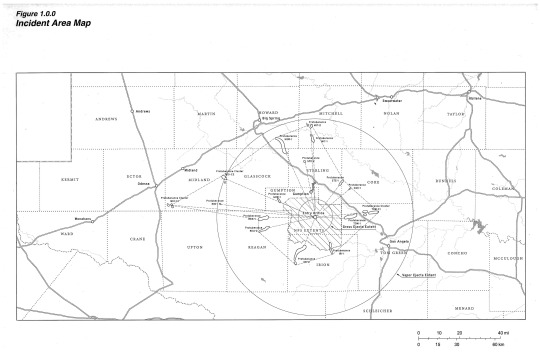
[1.0.0] Executive Summary
At 9:41 PM CST on July 4th, 2007, the Permian Basin Superorganism Natural Preserve (known colloquially as the “Mystery Flesh Pit National Park”) experienced a catastrophic disaster which resulted in over 750 fatalities, and over 1,800 major injuries. In the weeks following the incident, approximately 18,000 individuals from the surrounding communities sought medical and psychological treatment for ailments including breathing problems, chest pains, shortness of breath, nausea, birth defects, hallucinations, depression, anxiety, internal bleeding, sore throat, and headaches as a direct result of contact with gastric ejecta which had been introduced to the atmosphere.
Investigators have concluded that this disaster was chiefly characterized by a premature geobiological consumption event caused by the catastrophic failure of critical park infrastructure to constrain and limit the gastric, motor and neurological actions of the Permian Basin Superorganism.
Investigators have concluded that the failure of these critical safety measures are the direct result of negligent practices by the primary site operations contractor Anodyne Deep Earth Mining, a subsidiary of Anodyne, Inc.
The U.S. Commission on Geobiological Resources & Public Safety (CGR) released its first report on the Permian Basin Superorganism Disaster in August 2007 (“the Interim Report”), which highlighted technical findings and safety system deficiencies. The report issued recommendations to Anodyne, Inc.; the city of Gumption, Texas; the State of Texas; the U.S. Department of the Interior; the U.S. Environmental Protection Agency; the Federal Emergency Management Agency; the U.S. Food & Drug Administration; and the U.S. Department of Energy. As of April 2008, these groups have made progress in implementing the recommendations to improve the regulatory requirements for geobiological resource extraction, geobiological resource containment, and general public safety as it relates to the Permian Basin Superorganism.
[2.1.0] Anodyne Background
Anodyne was originally founded as the Anchor Mineral Co. in 1923. In 1958, the Anchor Mineral Co. merged with Dynamic Equipment, LLC. to form a new company known as Anodyne Deep Earth Mining, later changed to Anodyne.
Headquartered in Arlington, Texas, and prior to it’s 2008 restructuring, Anodyne Corporation was the twenty-third largest American company by revenue. Globally, Anodyne employed over 28,000 people. It operated seven major research, development and production facilities around the world, six of which were in the United States.
Anodyne filed for bankruptcy in late 2008, but ended it’s bankruptcy in February 2009 pursuant to a court-approved plan of reorganization. A new board of directors changed the name of Anodyne to the Permian Basin Recovery & Superorganism Containment Corporation, and emphasized reorganizing and liquidating certain operations and assets of the pre-bankruptcy Anodyne.
[2.2.0] Permian Basin Superorganism Background
The Permian Basin Superorganism (Immanis Colosseus, also known by the popular nomenclature of “Mystery Flesh Pit”) is a subterranean organism unique to modern biology, being the sole occupant of the PhylumImmanemqa. The organism was discovered by a pilot well drilling crew in 1973; later efforts were made to expose more of the organism through drilling and surface mining explosives.
The superorganism is chiefly characterized by its immense size, which is still a matter of geobiological debate. Surveys suggest that the organism may span many hundreds of miles beneath the permian basin horizontally, with scientists speculating that the organism may extend vertically into the upper mantle of the earth’s interior.
The complete anatomical layout and internal organization of the organism is unknown. Tissue samples suggest that the organism contains gastrointestinal, vascular, respiratory, musculoskeletal, nervous, limbic and integumentary systems with remarkable similarity to mammal life, while also containing a variety of systems which have no direct analog and are not fully understood. The feeding cycle of the organism is poorly understood and believed to occur on a complex and long-term schedule of dormancy and feeding activity. It has been hypothesized that the superorganism derives caloric energy from subterranean hydrocarbon deposits, though the organism has been observed to digest and absorb organic matter.
The depth at which the organism extends into the surrounding rock strata indicates that the organism is several hundred thousand years old. It is unknown what the natural lifespan of the species is, or if the Permian Basin Superorganism represents a mature or developing example of the species.
[3.0.0] Incident Timeline
Start of relevant timeline.
10:29 AM July 4th – Unseasonably high rains force park administrators to cancel a July 4th Concert and Fireworks display scheduled to take place on the surface park grounds. Many visitors who had already purchased tickets to the event become upset, and a decision is made to extend the park hours until midnight for those who had purchased event tickets.
8:00 PM July 4th – Normal closing time for the national park. A typical shift change of reduced night staff in the control room takes place.
9:16 PM July 4th – Harvesting crews working in the western extremities of the organism set a new extraction record to meet a quota for bonuses in time for the holiday weekend.
9:30 PM July 4th – Control room operators initiate a routine system self-test and discover a relay fault error resulting from increased electrical demand from mining equipment and tourist infrastructure. A control room operator logs the fault and notifies an on-duty engineer.
9:41 PM July 4th – Water drainage from surface rain into the Entry Orifice begins to collect in the sand gullet. Drainage pumps are automatically activated by a sensor system but fail to initialize due to the relay fault. An emergency back-up pump running on a separate emergency circuit is automatically activated.
9:42 PM July 4th – A critical alarm in the control room alerts operators that the emergency water pump has seized and is inoperative. Under-lubrication of the pump’s impeller bushings resulted in corrosion due to the moist interior of the flesh pit environment.
9:48 PM July 4th – Technicians arrive at the primary pump station to discover the sand gullet almost completely submerged. Water begins to pour over the dorsal respiratory ridge and into bronchial bulbules. Control room operators divert power to hydraulic stent rams to brace for expected choke response.
9:51 PM July 4th – Technicians a repair the relay fault as control staff reset the park’s electrical grid. The grid is offline for 45 seconds. The automatic PA system does not notify guests as the system is scheduled to automatically shut down at the normal 8:00PM closing time. The temporary lapse of lighting causes many guests to become panicked and return to the main gantry lift at the lower visitor center.
9:52 PM July 4th – A choking action from the organism begins 31 seconds into the electrical reset. The main dorsal trunk violently flexes. Lack of power to hydraulic arming rams causes irreparable damage to several sections of internal infrastructure.
9:53 PM July 4th – As the electrical system finishes the reboot cycle, the dynamic hydraulic actuators supporting the lower visitor center overcorrect for stability, not accounting for the shift in the wall lining of the nexial cavity in which the visitor center facility is anchored. Two of the six structural supports are torn from their foundations which causes the facility to list 20deg off vertical. The base joint of the vertical entry gantry is bent beyond its design limit angle.
9:54 PM July 4th – The Master Alarm is tripped automatically. Surface facilities are notified as response teams are given the order to mobilize.
9:56 PM July 4th – Park rangers are dispatched to rescue groups of visitors trapped in partially collapsed tunnels and trails.
10:03 PM July 4th – Continued movement of the organism, combined with rainwater, causes one of the upper entry gantry supports to slip. An outbound elevator conducts an emergency stop stranding over two dozen visitors.
10:05 PM July 4th - Tremors registered as far away as the DFW metroplex.
10:06 PM July 4th - Soil liquefaction destabilizes surface facilities in and around the organism. Dilation anchors begin retracting to keep the entry orifice open.
10:12 PM July 4th - A master fail-safe is activated by the automated park management system. Twenty thousand liters of aconitine compound are injected into the superorganism via a distributed network of relay stations located throughout it’s known internal anatomy.
10:12 PM July 4th - Tremors and convulsions intensify as the entry gantry connection to the lower visitor center detaches completely. The lower visitor center begins to collapse downward into the nexial cavity.
10:12 PM July 4th - Peristaltic muscle action of the nexial cavity begins to exert substantial pressure on the outer structure of the lower visitor center facility.
10:15 PM July 4th - The prime labiod junction just west of the Septum Falls geobiological feature flexes into an open position, releasing a torrent of lactogastric chyma into the dorsal trunk. It is likely that this was a reaction to the aconitine injection.
10:16 PM July 4th - Peristaltic spasms force the caustic chyma slurry through the nexial cavity and up through the lower and upper moisture crops towards the surface orifice.
10:16 PM July 4th - Many guests attempting to flee the stalled elevator near the entry orifice attempt climbing out the upper moisture crop but are ultimately unsuccessful due to torrential rains causing the surfaces to become very slippery. Many end up falling back into the maw.
10:17 PM July 4th - The chyma slurry erupts from the surface orifice in a geyser several hundred meters in height. Large pieces of undigested organic matter crush several vehicles and damage windows.
10:19 PM July 4th - Following the several minute long ejecta event, a deep and incredibly loud roar erupts from the entry orifice as ground tremors intensify further. Large extremities begin surfacing through bedrock and soil approx. 30km-120km from the entry orifice.
10:25 PM July 4th - The acrid smell of the gastric ejecta can be detected as far as Odessa, TX.
10:26 PM July 4th - Two park service vehicles and a tour vehicle containing park service employees and several guests attempt to ascend through the entry orifice tube.
10:27 PM July 4th - Peristaltic action crushes one of the tour vehicles and sucks the other two vehicles back into the nexial cavity and down into a digestive organ. These vehicles are presumed destroyed.
10:58 PM July 4th - The pentagon is given authorization from the whitehouse to use nuclear force if necessary to prevent the organism from entering an active and/or ambulatory state.
11:02 PM July 4th - The on-site operations director within the lower visitor center control room initiates a final fail-safe measure in the form of the [CONTINGENCY MEASURE].
11:02 PM July 4th - Master Event Log records successful spin-up of the [CONTINGENCY MEASURE].
11:05 PM July 4th - Lower visitor center structural integrity is critically compromised resulting in total collapse.
11:05 PM July 4th - Data connection with lower visitor center is severed.
11:13 PM July 4th - Spasms and motor action of the superorganism begins to noticeably subside. Response teams begin to descend into the surface orifice to attempt rescue operations.
11:19 PM July 4th - Response team encounters visitor group which had attempted escape from stalled elevator. Most are dead, the remainder are mortally wounded and partially digested due to caustic gastric ejecta.
11:42 PM July 4th - Radio contact established with ranger vehicle trapped within “Oyster’s Shame”. Due to ventricle closure, no feasible rescue strategy can be developed before complete mastication occurs.
11:56 PM July 4th - Response team confirms that [CONTINGENCY MEASURE] and associated facility are still intact and operating.
11:58 PM July 4th - Texas Gov. Rick Perry formally declares a state of emergency for Gumption county.
12:22 AM July 5th - Response teams route data/power umbilical to new basecamp in [CONTINGENCY MEASURE] facility.
12:35 AM July 5th - Three inter-pit lifeforms are identified as having been ejected onto the surface. Fifteen visitors are injured and seven are hunted by inter-pit lifeforms during panicked evacuation of surface resort.
12:41 AM July 5th - Park staff manage to kill the three large lifeforms.
1:02 AM July 5th - National Guard helicopters begin delivering supplies and personnel to aid in site containment.
1:58 AM July 5th - Field hospital is constructed to care for wounded visitors and staff.
2:37 AM July 5th - Initial damage surveys report catastrophic destruction of internal park infrastructure. Pit geobiology has dramatically changed in hazard level.
3:00 AM July 5th - Emergency teleconference of Anodyne executive leadership. National parks director and Secretary of the Interior are present.
3:12 AM July 5th - Executive decision is made to initiate FEMA response and assemble a task force for containing superorganism.
4:00 AM July 5th - Media helicopters and vehicles begin to report on the scope of disaster.
4:39 AM July 5th - Base camp technicians begin to spin-down [CONTINGENCY MEASURE]. Large fractures due to inertial stress have appeared on mineral components. Engineers advise against re-initializing [CONTINGENCY MEASURE] until mineral components can be replaced or repaired.
6:08 AM July 5th - Ground personnel begin assembling a pump system to inject industrial sedatives into the superorganism. Transport trucks containing industrial sedative arrive.
9:45 AM July 5th - Emergency teleconference of Anodyne shareholders.
11:20 AM July 5th - Several injured visitors inexplicably leave field hospital and begin walking towards open pit orifice. Approx. 38 individuals are able to crawl back into the orifice over the course of 8 hours. None are recovered.
3:51 PM July 5th - Radio transmission from trapped ranger vehicle ceases. Many speculate that other small groups of visitors and staff are still trapped.
End of relevant timeline.
[4.0.0] Final Investigation Report
The following Final Investigation Report addresses additional investigation findings not covered in the previous report, including analysis of (1) the Anodyne organization, emergency response, and safety culture; (2) industry disaster response standards; (3) structural integrity standards; and (4) effective performance of “mystic” contingency measures.
[4.1.0] Technical findings
This report highlights the following technical findings. (An in-depth discussion appears in the Interim Report)
[4.1.1]The electrical distribution scheme for the interior operations of the Permian Basin Superorganism Nature Preserve was modeled on a typical supply/load grid layout often found in mines, with power provided by a gas-fired plant located within the surface support compound. Unlike typical mining power distribution networks, the power load was split with the facilities involved in the tourism and natural preservation operations within the organism. This split-demand yielded a load fluctuating from 33kV to 60kV depending on a range of factors from resource extraction output, visitor throughput, hydrostatic and barometric fluctuations within the organism, and the ambient blood pressure of the organism. This unorthodox load distribution scheme required careful demand oversight and was subject to failure if operated outside of design load specifications. Such a failure occurred on July 4th, 2007 when operators increased electrical demand beyond design load specifications by both extending resource extraction operations while simultaneously increasing visitor throughput loads on trail infrastructures.
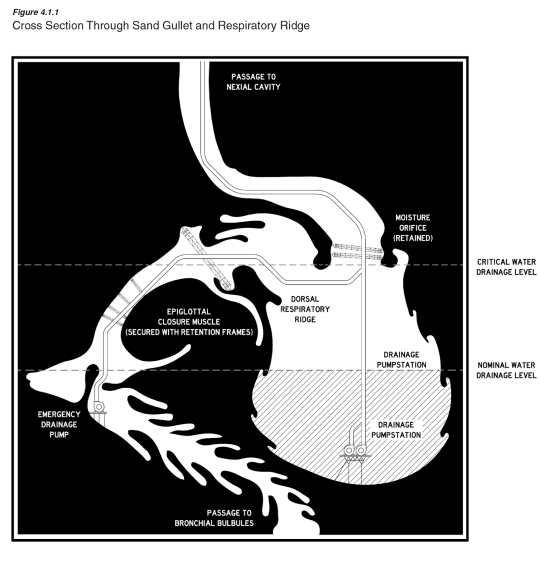
[4.1.2] Hydrochloric corrosion is common in geobiological resource extraction, where naturally occurring hydrochloric compounds react with steel equipment. Process variables that affect corrosion rates include the total hydrochloric content of the enzyme secretions, flow conditions, application of TUMS industrial organic corrosion inhibitor salve, and the system temperature and humidity. Virtually all geobiological operations equipment is subject to this type of corrosion, and requires routine inspections and preventative maintenance to ensure that metallic and non-metallic corrosion prone surfaces are operating at design strength. The investigation has concluded that the corrosion found within the primary impeller bushings within the Emergency Drainage Pumps was caused by Hydrochloric corrosion due to poor maintenance.
[4.1.3] Foundations and other anchor support structures within the Permian Basin Superorganism are critical components of park infrastructure which require careful planning and construction oversight. Under nominal conditions, anchor sites are selected by engineers to meet design load specifications with consultation from venteriobiologists for minimum anatomical disturbance. Rigid geobiological strata such as bone and dense cartilage are most often selected for load-bearing anchor points for their relative stability and similarity to conventional load-bearing strata such as rock. However, many locations within the Permian Basin Superorganism are primarily characterised by dense compositions of soft tissues requiring novel anchoring solutions. Several anchors within the primary entry tube utilize a cleat-based stent system which engages the entry tube muscle walls. These forces are equalized by the use of circular retention trusses which, when combined with vibration dampening actuators, form a rigid support assembly upon which fixed components such as the entry gantry may be affixed. Peristaltic action of a muscle tube has the potential to rotate a circular cleat sent frame by up to 90deg, eliminating the retaining capabilities of the frame. It is for this reason that design specification standards call for the installation of either rigid or tensile support members between consecutive retaining frames. In cases such as within the entry tube, tensile cables were selected to provide this support. These cables are subject to corrosion and must be routinely inspected in order to ensure that they meet minimum design load specifications. The investigation has concluded that the cables installed on the entry tube retaining frame system were improperly maintained and failed due to corrosive weakening of the cable members.
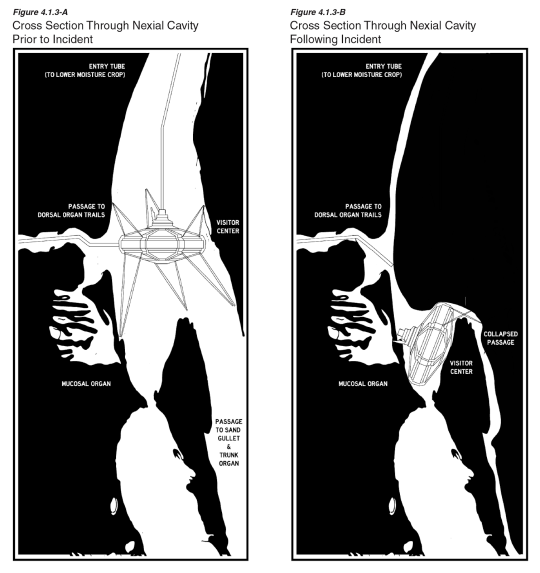
[4.1.4] The use of a previously-untested contingency measure by operators, while not the primary inciting incident of the disaster, is a prime contributor to the outstanding collateral damage. A network of sensor stations embedded throughout the Permian Basin Superorganism had acted as a distributed sensory system, intended by park planners to provide a method for observing large-scale changes to the organisms condition. As an experimental contingency measure, each station was outfitted with a mechanism capable of injecting up to 15L of a concentrated aconitine solution. Aconitine is commonly used as an acute toxin for large mammals such as whales and was chosen for its theoretical effectiveness on key muscle groups within the organism. Park planners were under the assumption that a rapid injection of large volumes of aconitine would act as a sedative agent without inducing tissue death beyond the immediate injection sites. The investigation has concluded that this injection failsafe was directly responsible for escalating the motor response of the organism to levels beyond the design load strength of critical park infrastructure. The investigation has also concluded that the aconotine injection failsafe was directly responsible for causing the toxic “shock” response within the organism which resulted in a Gastric Ejecta Event.

[4.1.5]The [CONTINGENCY MEASURE] is hypothesized to function by utilizing a series of standing harmonic and ultrasonic wavelengths which have been observed to affect the overall behavior of the Permian Basin Superorganism. These waves are created by applying a 15MHz mechanical percussion to the face of an excavated large quartz crystal (also known as “Mystic Artifacts #15, #21 and #22”). Once struck, the unique properties of the relic propagate the wave outward and into the surrounding anatomy of the Permian Basin Organism. When placed upon a rapidly rotating turntable, the effect can be multiplied and oriented allowing a high degree of theoretical influence over the organism. This contingency measure was activated only once and demonstrated the potential application this technology may have in future containment measures. However, at the time of this investigation, no additional relics have been located intact. Without this key assembly component, the CGR does not recommend additional experimental uses of the [CONTINGENCY MEASURE].
[4.2.0] Organizational Findings
[4.2.1] Anodyne did not effectively implement internal recommendations to help prevent structural failures to hydrochloric corrosion. In the 8 years prior to the incident, a small number of Anodyne personnel with knowledge and understanding of venteriobiology recommended on several occasions either a one-time inspection of every component within the primary inter-park infrastructure system - known as a 100 percent component inspection - or an upgrade of the material of construction of these key infrastructure components. The recommendations were not implemented effectively, and many key structural and mechanical components remained in service until failure on July 4th, 2007.
[4.2.2] Anodyne failed to perform internally recommended 100 percent component inspections. Anodyne metallurgists released a formal report dated September 30, 2004 (nearly 3 years before the incident), titled Updated Inspection Strategies for Preventing Hydrochloric Corrosion Failures in Critical Systems. The investigation has concluded that these recommendations were not properly implemented.
[4.2.3] The CGR identified several contributing causes of the July 5th, 2007, incident relating to the safety culture at Anodyne:
- Decision making that encourages continued operation of tourism and resource extraction operations despite hazardous working conditions.
- Reluctance among employees to use their Stop Work Authority. Recent safety culture surveys performed within resource extraction sites indicate that employees had become less willing to use their Stop Work Authority between 2003 and 2006; and
- Substandard equipment maintenance practices. Those same surveys indicate that Anodyne employees saw increased problems in how the internal operations infrastructure maintained its equipment between 2003 and 2006.
[4.2.4] Anodyne did not effectively identify in the Incident Command structure the damage mechanisms that could have caused the failures on the night of the incident. The OSHA Hazardous Operations and Emergency Response (HAZOPER) standard states that the Incident Commander “Shall identify, to the extent possible, all hazardous conditions present.” in an emergency response situation. However, the appropriate technical expertise necessary for identification was not effectively consulted in the Incident Command Structure on July 5th, 2007. This lack of knowledge of all potential causes of the incident led the Incident Commander to direct emergency responders to take actions that may have ultimately exacerbated the hazard condition and put many Park Service personnel, Anodyne personnel, as well as civilian visitors, in harm’s way. It also led the Incident Commander to limit the “hazard zone” to a small area that did not consider the possibility of a Gastric Ejecta Event. When the Gastric Ejecta Event occurred, personnel and emergency equipment positioned in the “safe zone” were engulfed in the volume of caustic ejecta.
[5.1.0] Incident Conclusions
[5.1.1] The CGR found that the failure of this incident is indicative of a fragmented hazard management approach that placed the responsibility to implement safety recommendations on stakeholders which stood to benefit from decreased oversight while also incurring financial loss for any safety oversight restrictions placed. Consequences of this cultural attitude surrounding the tourism and resource extraction operations within the Permian Basin Superorganism led to the severe underestimation of the capabilities of the organism as well as the capabilities of the systems designed to limit the hazards posed by the organism.
[5.1.2] The use of concentrated aconitine, without prior study or approval, as a fail-safe directly triggered a reactionary response from the organism which led to the deaths of over 750 individuals.
[5.1.3] The use of the [CONTINGENCY MEASURE], while effective at “pacifying” the organism, was similarly employed without prior substantial testing or approval. This lack of communication from Anodyne regarding the specifics, theory of operation, and even existence of the artifacts , which are essential components within the [CONTINGENCY MEASURE], directly led to the unsafe, high-RPM operation which fractured the mineral components of the [CONTINGENCY MEASURE].
[5.2.0] General Recommendations
[5.2.1] The CGR, with full support from the U.S. Department of the Interior, the U.S. Geological Survey, and the National Park Service, has made the discretionary recommendation to not pursue additional commercial development within or adjacent to the boundaries of the Permian Basin Superorganism.
[5.2.2] In the interest of continuing the present containment operations while also ensuring readiness in the event of a future geobiological action event, the CGR has developed a comprehensive program of monitoring and containment. This program is divided into a series of objectives, intended to better mitigate the hazard presented by the existence of the Permian Basin Superorganism.
[5.2.3] Improve the communication of geobiological-hazard science for use in decision and policy making.
- Support the use of geobiological-hazard science in risk reduction with engineering, environmental science, spiritual and social sciences.
- Improve understanding among venteriobiologists, engineers, and others of numerical simulation of organism ground activity as opposed to the use of empirical ground-motion-prediction equations.
- Improve understanding of the benefits of early warning systems.
- Educate about organism movement patterns and operational activity forecasts.
[5.2.4] Advance basic knowledge of geobiological action event hazards and inform actions to reduce the risk of the organism becoming non-dormant
- Develop a new method to estimate stimulus-response outcomes in interactions with the Permian Basin Superorganism without reliance on expert opinion, proprietary computer models, or wholly “mystic” ritual methods without demonstrated patterns of reliability.
- Educate and facilitate local containment capabilities to deal with fauna and other life forms which are native to the organism’s interior anatomy.
- Develop methods for production and administration of appropriate sedative measures to chemically induce a comatose state of inactivity in the organism.
- Where it is absolutely necessary for personnel to descend into the organism, develop methods to reduce the possibility of individuals becoming trapped.
- Establish a perimeter area surrounding the Incident Site to protect the health and safety of the public from additional fauna incursions or ejecta events.
[5.3.0] Containment Recommendations
[5.3.1] A thorough plan for containment of the organism has been devised by a joint containment task force comprised of geobiologists, venteriobiologists, seismologists, medical experts, engineers from various disciplines, land management specialists, ecclesiastical personnel, as well as representatives from private industry. This proposed containment procedure integrates a variety of strategies intended to prolong the dormancy of the Permian Basin Superorganism while simultaneously reducing the likelihood of a future geobiological action event.
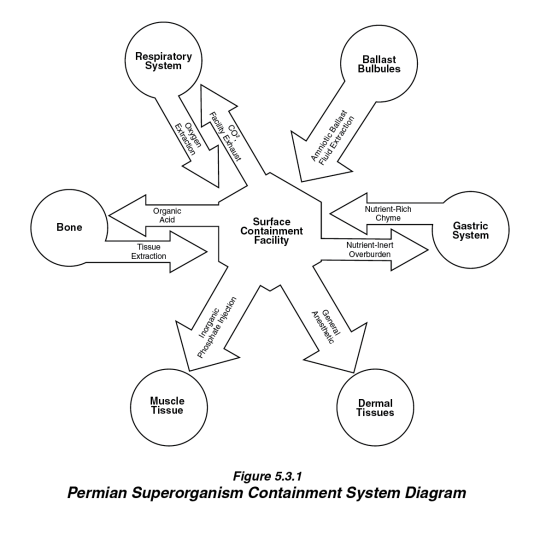
The taskforce has recommended the establishment of a >3km restricted access zone surrounding the Entry Orifice defined by a reinforced and patrolled barrier. Signs and other warning devices should be installed to clearly inform the public of the hazard(s) presented by the containment operations and the Superorganism itself. Where possible, the taskforce has recommended that any material necessary for the containment operations be produced on-site so as to minimize logistic dependency on remote facilities.

The recommended multi-strategy containment plan is outlined as follows:
- All efforts should be made to maintain a steady introduction of high-potency anesthetic to the uppermost dermal anatomy of the organism. This is the foremost measure for reducing the capability of the Superorganism to sense and perceive human activity.
- At a similar volume to high-potency anesthetics, the introduction of inorganic phosphates directly into the muscles of the Superorganism is an essential strategy designed to delay and fatigue the motor response of the organism.
- Where possible, the introduction of acidic compounds into bone structures will further weaken the overall response capability of the Superorganism in the event that other containment precautions fail. Special care should be taken to ensure that primary structural members of the organism’s skeletal system are not weakened, however, as such a measure could potentially damage critical infrastructure.
NOTE: As of rev. 18.3 of this document, the Permian Basin Recovery & Superorganism Containment Corporation has been granted a temporary permit for the continued extraction of bone material and amniotic fluid ballast for research and limited commercial purposes. - The taskforce has recommended measures which would induce a state of mild hypoxia in the Superorganism through the replacement of oxygen-rich air with carbon dioxide-rich air within the respiratory systems of the organism. In addition, by venting plant exhaust from the surface containment facility directly into the organism, this plan remains in compliance with standing EPA regulations on emissions within natural preserves.
- The extraction of nutrient-rich material from within the Superorganism’s gastric systems is an additional preventative step recommended by the task force to weaken the response capability of the organism. In order to prevent a hunger response, the task force has recommended displacing the volume of nutrient-rich material with that of an inert material such as gravel or rock.
NOTE:As of rev. 2.5 of this document, materials and objects harvested from the Retrocognitive Material Gestation Organs (A.K.A. “Gift Gardens”) will continue at a greatly reduced capacity for the exclusive purpose of research. All such objects shall be stored in a designated and secure off-site facility.
[6.0.0] Conclusion
The CGR concludes its recommendations and report with broad advocacy for any such program(s) which aim to better prepare physical as well as social and spiritual infrastructure for the inevitability of the Permian Basin Superorganism emerging from dormancy and becoming completely active and ambulatory. The measures and methods described within these recommendations are temporary in their effectiveness while representing the fullest extent of human capability to impact the Permian Basin Superorganism. Future studies and capabilities may yield a greater degree of readiness in matters concerning the survivability of a societal encounter with an active and ambulatory Immanis Colosseus, but it is unrealistic to believe that mankind will be able to seriously damage or eliminate such an organism.
Inhabitants of the western hemisphere, within the U.S. and Abroad, must come to understand the losses each and every one of us will face, and how those impacts will harm the quality of life we enjoy in this unique part of the world.
[End of Document]
This document represents an executive overview of the now-infamous July 2007 disaster which permanently closed the Mystery Flesh Pit National Park. Though the initial hazard and containment response was praised by many for it’s quick and decisive action, many have criticized the government for continuing to allow the Permian Basin Recovery & Superorganism Containment Corporation (Formerly Anodyne, Inc.) a commercial stake in the containment efforts.
More info about this project can be found at the subreddit /r/FleshPitNationalPark, the official Discord, or at the blog mysteryfleshpit.tumblr.com
The dark and constantly-shifting interior of the Mystery Flesh Pit National Park has been a formidable challenge to navigation since its discovery. Tethered explorations early in the history of the park mitigated this problem, but more comprehensive surveys eventually required a novel solution. By using a standard magnetic compass in combination with a barometer, a directional bearing and relative depth within the organism can be obtained. Of course, these two items of information are alone insufficient and require a small assortment of other physical and chemical orienteering solutions to effectively navigate within the superorganism. Still, devices similar to the Anodyne-produced unit photographed here have been and continue to be invaluable basic tools for park rangers, engineers and technicians who need to know where they are within the park.
Post link

